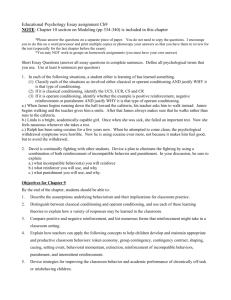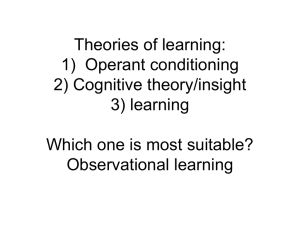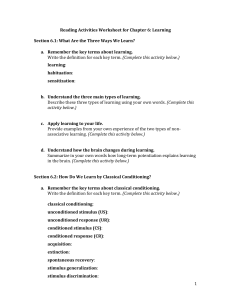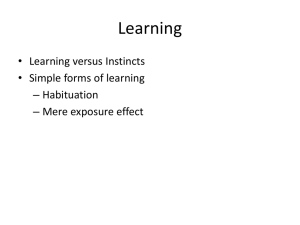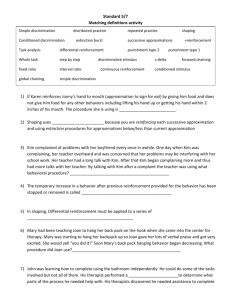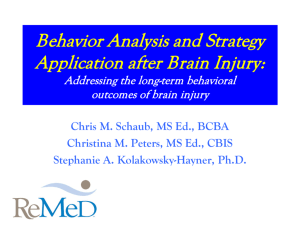Learning Practice Questions
advertisement
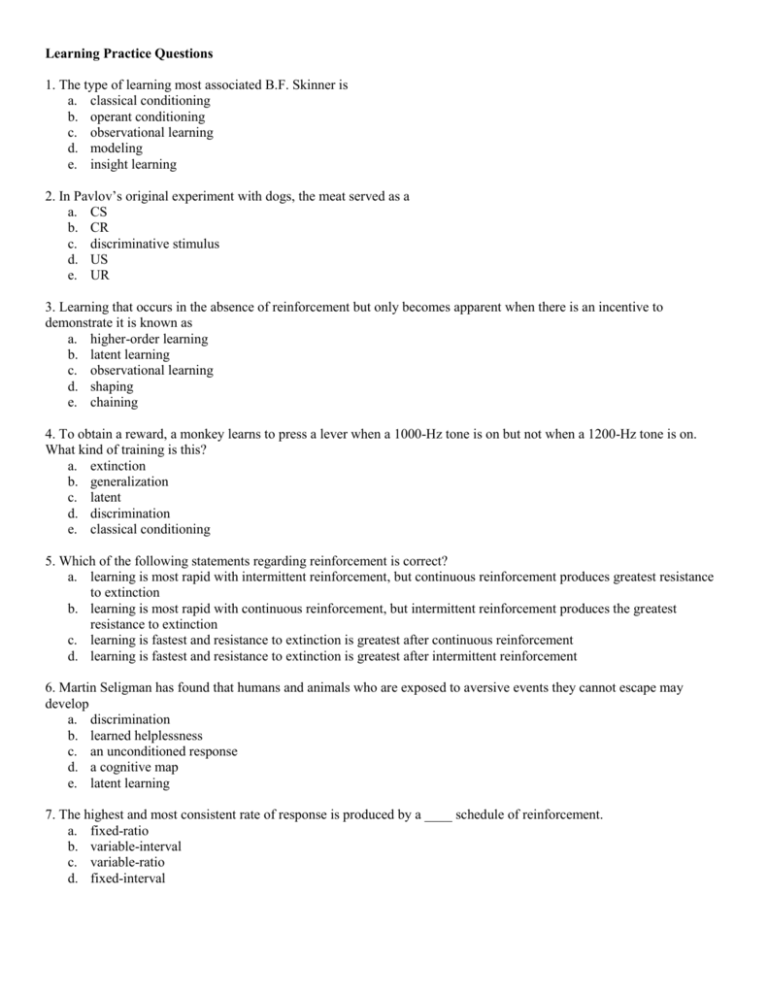
Learning Practice Questions 1. The type of learning most associated B.F. Skinner is a. classical conditioning b. operant conditioning c. observational learning d. modeling e. insight learning 2. In Pavlov’s original experiment with dogs, the meat served as a a. CS b. CR c. discriminative stimulus d. US e. UR 3. Learning that occurs in the absence of reinforcement but only becomes apparent when there is an incentive to demonstrate it is known as a. higher-order learning b. latent learning c. observational learning d. shaping e. chaining 4. To obtain a reward, a monkey learns to press a lever when a 1000-Hz tone is on but not when a 1200-Hz tone is on. What kind of training is this? a. extinction b. generalization c. latent d. discrimination e. classical conditioning 5. Which of the following statements regarding reinforcement is correct? a. learning is most rapid with intermittent reinforcement, but continuous reinforcement produces greatest resistance to extinction b. learning is most rapid with continuous reinforcement, but intermittent reinforcement produces the greatest resistance to extinction c. learning is fastest and resistance to extinction is greatest after continuous reinforcement d. learning is fastest and resistance to extinction is greatest after intermittent reinforcement 6. Martin Seligman has found that humans and animals who are exposed to aversive events they cannot escape may develop a. discrimination b. learned helplessness c. an unconditioned response d. a cognitive map e. latent learning 7. The highest and most consistent rate of response is produced by a ____ schedule of reinforcement. a. fixed-ratio b. variable-interval c. variable-ratio d. fixed-interval 8. A response that leads to the removal of an unpleasant stimulus is one being a. positively reinforced b. negatively reinforced c. positively punished d. negatively punished e. extinguished 9. When a conditioned stimulus is presented without an accompanying unconditioned stimulus, ____ will soon take place. a. generalization b. discrimination c. aversion d. helplessness e. extinction 10. One difference between classical and operant conditioning is that a. in classical conditioning, people learn associations between events or stimuli they can’t control b. in operant conditioning, the responses are automatic or involuntary c. in classical conditioning, the association is made due to the outcome or consequence after the event d. in operant conditioning, learning occurs due to a stimulus that precedes the event 11. Classical conditioning is strongest when a. the CS is presented shortly after the US b. the US is presented immediately after the CS c. the UR occurs shortly before the CS d. the CS is presented at the exact same time as the US e. the US is presented at least an hour after the CS 12. In Watson’s study, Albert’s fear of the loud noise was the a. UR b. CR c. US d. CS 13. Learning by imitating others’ behaviors is called ____ learning. The researcher best known for this type of learning is _____. a. secondary; Skinner b. observational; Bandura c. secondary; Pavlov d. observational; Watson e. operant; Thorndike 14. Punishment is a controversial way of controlling behavior because a. the behavior is forgotten b. punishing stimuli can often create fear c. punishment decreases aggressiveness d. punishment prevents the child from learning discrimination 15. ____ are found in the brain’s ____ and are believed to be the neural basis for observational learning. a. mirror neurons; temporal lobe b. synaptic clefts; frontal lobe c. mirror neurons; frontal lobe d. association areas; temporal lobe e. CREB proteins; temporal lobe 16. Professor Bob gives pop-quizzes sometimes after two days of class, sometimes after two weeks, and other times after a month has gone by. This illustrates the ___ schedule of conditioning. a. fixed-interval b. fixed-ratio c. variable-interval d. variable-ratio 17. Rewarding the successive approximations, or steps, toward a complex behavior is known as a. discrimination b. generalization c. modeling d. observational learning e. shaping 18. Jack finally takes out the garbage so that his father will stop pestering him. Jack’s behavior is influenced by a. positive reinforcement b. negative reinforcement c. positive punishment d. negative punishment 19. A pigeon can easily be taught to flap its wings to avoid shock but not for food reinforcement. This is most likely so because a. pigeons are biologically predisposed to flap their wings to escape aversive events, but not for food b. shock is a more motivating stimulus for birds than food is c. hungry animals have difficulty delaying their eating long enough to learn a new skill d. an extinguished response will usually recover after a couple of days 20. After discovering that her usual route home was closed due to road repairs, Sharetta used her knowledge of the city and sense of direction to find an alternate route. This is an example of a. latent learning b. observational learning c. a cognitive map d. shaping e. operant conditioning 21. Which of the following is an example of shaping? a. a dog learns to salivate at the sight of a box of dog biscuits b. a new driver learns to stop at an intersection when the light changes to red c. a parrot is rewarded first for making any sound, then for making a sound similar to “Laura”, and then for “speaking” its owner’s name d. a psychology student reinforces a laboratory rat only occasionally, to make its behavior more resistant to extinction e. a child throws a tantrum so that her parent will buy her a toy 22. Lars, a shoe salesman, is paid every two weeks, whereas Tom receives a commission for each pair of shoes he sells. Evidently, Lars is paid on a ___ schedule of reinforcement, and Tom on a ___ schedule of reinforcement. a. fixed-ratio; variable-interval b. variable-interval; fixed-ratio c. variable-interval; variable-ratio d. continuous; intermittent 23. A laboratory rat shows initial distress at the flashing of a bright light, but shows less distress with repeated exposure to the light. This is known as a. extinction b. habituation c. modeling d. shaping e. chaining 24. ____ refers to pairing an established CS with a neutral stimulus , causing the neutral stimulus to be a weaker CS. a. secondary reinforcement b. primary reinforcement c. higher-order conditioning d. shaping 25. In Pavlov’s original experiment with dogs, the tone was initially a(n) ____ stimulus; after it was paired with the meat, it became a(n) ___ stimulus. a. conditioned; neutral b. conditioned; unconditioned c. neutral; conditioned d. generalized; discriminative e. neutral; latent



